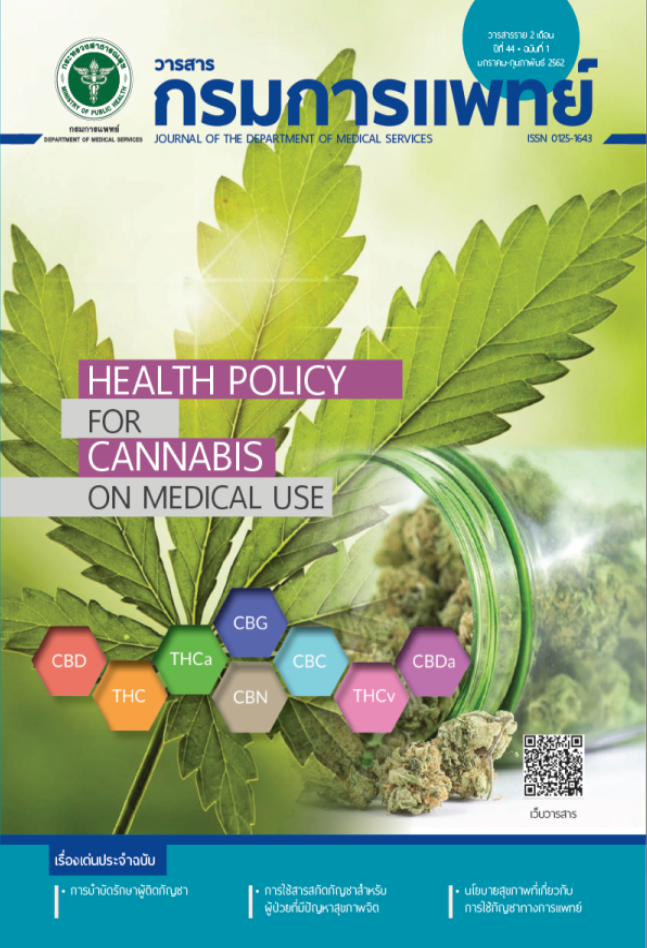The Comparison of Effects of Susceptibility Artifacts and Long Echo Time (TE) in Diffusion MRI by Single-Shot Echo-Planar Imaging and Readout-Segmented Echo-Planar Imaging at Prasat Neurological Institute
Keywords:
Diffusion Weighted Imaging (DWI), Susceptibility artifact, Susceptibility artifact, Readout-Segmented Echo-Planar Imaging (RS-EPI), Single-shot Echo-Planar Imaging (SS-EPI)Abstract
The aim of this study was to compare susceptibility artifact and effect of long echo time (TE) between single-shot echo-planar imaging (SS-EPI) and readout-segmented echo- planar imaging (RS-EPI) diffusion weighted imaging (DWI) in 3 Tesla MRI machine at Prasat Neurological Institute. This was a retrospective study of 38 patients who underwent SS-EPI and RS-EPI DWI in each group. All scans were performed on a 3T MR scanner using 32 channel head coil. Susceptibility artifacts (geometric distortion, hyper-intensity signal and signal loss) and effect of long TE (will result in signal to noise ratio; SNR) were evaluated on diffusion trace images. The anatomic information of T2- weighted images was used to compare distortion with EPI DWI images. The study was done in five topics: number of slices that contain hyper-intensity signal, the severity of susceptibility artifacts (evaluated in image quality scale), geometric distortion (quantitative evaluation), comparing the effect of metal-induced artifacts between SS-EPI and RS-EPI DWI and comparing SNR between SS-EPI and RS-EPI DWI. The results showed that mean (SD) of slices containing hyper-intensity signal in SS-EPI is 5.92 (1.09) and in RS-EPI DWI is 2.73 (1.13) (P<0.001). The susceptibility artifacts in SS-EPI image was prominent compared with RS-EPI DWI (different in 3 levels of image quality scales). The different distance between SS-EPI วารสารกรมการแพทย์88and RS-EPI DWI at the level of cerebellar hemispheres, the level of lateral ventricles in phase direction and the level of lateral ventricles in frequency direction with its own T2-weighted images at the same position were 2.49 mm/1.00 mm, 6.03 mm/ 2.13 mm, and 1.27 mm/0.89 mm, respectively (P<0.001). The effect of metal-induced artifacts is quite severe (level 3-4) to 87.5% in SS-EPI DWI, while only 30% found in the RS-EPI DWI (P=0.031). Mean (SD) of SNR at the cerebellum in SS-EPI and RS-EPI were 161.14 (29.29) and 150.85 (51.21), respectively (P=0.287). Mean (SD) of SNR at the level of lateral ventricles in SS-EPI and RS-EPI were 141.63 (27.07) and 123.04 (42.46), respectively (P= 0.026). The ratios of SNR between RS-EPI and SS-EPI DWI were 0.94 for the cerebellum and 0.87 for the level of lateral ventricles. This study shows that RS-EPI has less susceptibility artifacts (geometric distortion, hyper-intensity signal and signal loss) than SS-EPI in diffusion trace image, especially at the regions which have different magnetic susceptibilities that are juxtaposed or with patient who have metallic implants and devices. Patients who have pathology in these areas or have metallic implants or devices, should select RS-EPI sequence to perform DWI.
References
Kwee TC, Galban CJ, Tsien C, Junck L, Sundgren PC, Ivancevic MK, et al. Comparison of apparent diffusion coefficients and distributed diffusion coefficients in high-grade gliomas. JMRI 2010; 31: 531-37.
Porter DA, Heidemann RM. High resolution diffusion-weightedimaging using readout-segmented echo-planar imaging, parallel imaging and a two-dimensional navigator-based reacquisition. Magn Reson Med 2009; 62:468-75.
Rowley HA, Grant PE, Roberts TP. Diffusion MR imaging. Theory and applications. Neuroimaging Clin N Am 1999; 343-61.
Chawla S, Kim S, Wang S, Poptani H. Diffusion-weighted imaging in head and neck cancers. Future Oncol 2009; 5: 959-75.
Peters NH, Vincken KL, Bosch MA, Luijten PR, Mali WP, Bartels LW. Quantitative diffusion weighted imaging for differentiation of benign and malignant breast lesions: the influence of the choice of b-values. J Magn Reson Imaging 2010; 31: 1100-5.
Oehler MC, Schmalbrock P, Chakeres D, Kurucay S. Magnetic susceptibility artifacts on high-resolution MR of the temporal bone. AJNR Am J Neuroradiol 1995; 16: 1135-43.
Iima M, Yamamoto A, Brion V, Okada T, Kanagaki M, Togashi K, et al. Reduced-distortion diffusion MRI of the craniovertebral junction. AJNR Am J Neuroradiol 2012; 33: 1321-5.
Adad JC. High-resolution DWI in brain and spinal cord with syngo RESOLVE. Magnetom flash 2/2012, 16-23.
Holdsworth SJ, Yeom K, Skare S, Gentles AJ, Barnes PD, Bammer R. Clinical application of readout-segmented echo-planar imaging for diffusion-weighted imaging in pediatric brain. AJNR Am J Neuroradiol 2011; 32: 1274-9.
Le Bihan D, Poupon C, Amadon A, Lethimonnier F. Artifacts and pitfalls in diffusion MRI. J Magn Reson Imaging 2006; 24: 478-88.
Hargreaves BA, Worters PW, Pauly KB, Pauly JM, Koch KM, Gold GE. Metal-induced artifacts in MRI. AJR Am J Roentgenol 2011; 197: 547-55.
Downloads
Published
How to Cite
Issue
Section
License
บทความที่ได้รับการตีพิมพ์เป็นลิขสิทธิ์ของกรมการแพทย์ กระทรวงสาธารณสุข
ข้อความและข้อคิดเห็นต่างๆ เป็นของผู้เขียนบทความ ไม่ใช่ความเห็นของกองบรรณาธิการหรือของวารสารกรมการแพทย์



